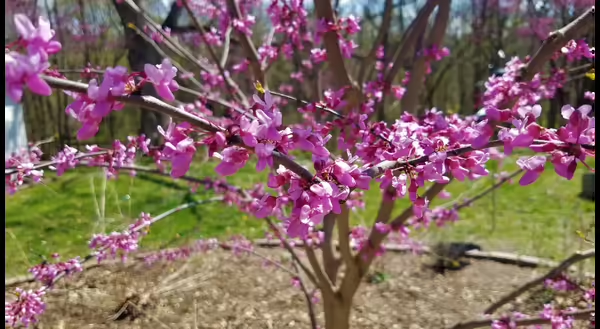
Spring is a time of abundant blooms as well as one of the best times of year to establish new woody plants in your landscape. This year, consider adding one, or all, of my favorite Illinois native spring-flowering trees to your landscape, and you’ll enjoy spring floral displays for years to come.
My top four spring-flowering trees - flowering dogwood, redbud, downy serviceberry, and red buckeye - are all relatively small in size, making them an easy fit for most planting locations, and all provide unparalleled spring flowers while supporting native insect populations.
Flowering Dogwood (Cornus florida)
Flowering dogwood is one of the classic spring flowering trees in Illinois forests. It frequents forest edge locations with slightly more sunlight than the forest interior, making it adapted to full sun or partial shade locations.
Dogwood flowers are unmistakable in their appearance among other native species. The flower structure is actually quite small and green, whereas the showy, white “petals” are actually bracts, or modified leave structures. This creates a truly unique and attractive bract display that persists for about one month each spring.
Beyond ornamental value, this plant is packed with ecological benefit as it supports more than 100 species of native caterpillars.
Flowering Dogwood is hardy for Zones 5-9, so Illinois is at the northern extent of its range in the U.S. When purchasing a new dogwood, be sure to source plant materials locally to ensure your tree is hardy for your area of Illinois. Some more southern genotypes suffer from a poor flower display due to winter kill of flower buds. Although they remain healthy, their flowing display is not always consistent.
Redbud (Cercis canadensis)
Redbud can be considered the other classic spring flowering tree in Illinois forests. Redbud and Dogwood occupy similar locations in the forest, near edges and with coinciding flower displays, together they help mark the awakening of our forests each spring. They make wonderful planting companions offering a great combination of native flowering species that truly bring the beauty of our native flora to the built environment.
The floral display of redbud is perhaps one of the best of any small tree in Illinois. For over a month, the tiny pink to purple flowers adorn stems nearly from tip to base creating a canopy of flowers prior to leaf emergence.
Like flowering dogwood, redbuds are well suited to full sun or partial shade planting locations. Both plants reach a mature size of about 20-30 feet tall. They both require well-drained soils, so they are not suited to locations with poor drainage or high soil compaction.
Redbuds tend to have a more spreading and multi-stemmed habit, whereas dogwoods are more compact and tend to be single stemmed and more tree-like in appearance.
Downy Serviceberry (Amelanchier arborea)
If you are interested in a multi-stemmed plant, downy serviceberry is a spectacular spring flowering tree with four seasons of ornamental interest. The show starts in spring with several weeks of clustered white flowers that give way to edible reddish-purple fruits. As fruits mature, they provide an attractive summer display when contrasted against the pleasant light green foliage. Fall color on this plant is among the best of any small tree in Illinois. Winter interest is provided by its distinctive light-gray, smooth bark that is only enhanced by its unique and branching multi-stemmed habit.
Serviceberry does well in full sun to partial shade, but does need some space to spread out as the mature height (15-20 feet) is often exceeded by its spread. However, more narrow single-stemmed specimens are typically available at most nurseries if a more compact habit is desirable.
Downy serviceberry can sometimes be difficult to source at nurseries, but many offer a close second choice of the also native, Allegheny serviceberry (Amelanchier laevis). There are also a number of hybrid varieties of these two native serviceberries that are commonly available and perhaps the easiest to find.
Red buckeye (Aesculus pavia)
Red buckeye is a smaller-sized native tree with quite distinctive flowers and leaves as well as an interesting multi-stemmed growth habit. The large, bright pinkish-red clusters of flowers are hard to miss each spring as they persist for about two weeks at the branch tips of each stem in the canopy. This smaller-sized native tree also has interesting and characteristic buckeye leaves, consisting of five palmately arranged leaflets in each compound leaf structure. It is a great plant for a smaller site with more demanding conditions.
Among other pollinators, red buckeye is noted to support hummingbirds with its tall clusters of nectar-filled, showy flowers each spring that coincide with spring migration. This native plant is deer and rabbit resistant as stems and foliage are toxic to mammals.
Both red buckeye and serviceberry are much more adapted to poor soil drainage or compaction and would be better choices for tough soil conditions. In addition, red buckeye can handle nearly any light level from full sun to full shade, making it the most versatile plant on my top four list.